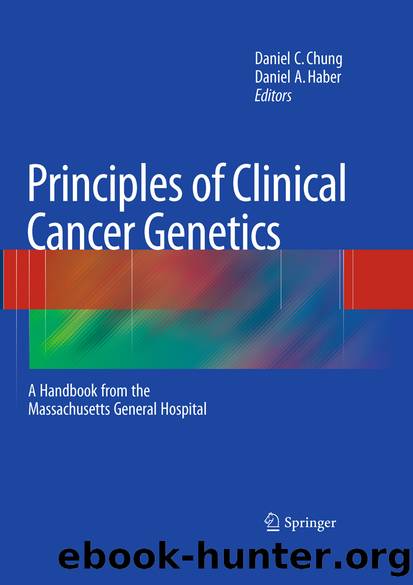Principles of Clinical Cancer Genetics by Daniel C. C. Chung & Daniel A. A. Haber

Author:Daniel C. C. Chung & Daniel A. A. Haber
Language: eng
Format: epub
Publisher: Springer US, Boston, MA
Diagnostic Considerations
The consensus diagnostic criteria are an effective standard for identifying affected probands. In contrast to VHL disease (discussed in the previous section), genetic testing for mutations in TSC1 and TSC2 genes is reserved for the purposes of molecular confirmation in clinically borderline cases. However, the mutation detection rate for both genes combined is ∼80–85%, leaving a moderate number of suspected probands without an identifiable gene mutation but still at risk for developing TSC1/2-associated lesions. Simplex (i.e., no significant family history) or borderline cases with no detectable germline mutation should still be followed on a regular basis, particularly if the initial evaluation occurs in childhood, as additional features of TSC may present later in life.
Genetic testing may also serve the purpose of identifying at-risk family members and for providing prenatal diagnosis and/or pre-implantation genetic diagnosis. The complicating feature in genetic counseling for TSC is the high apparent de novo mutation rate, where two thirds of affected probands represent new mutations.
Patients with de novo TSC mutations are more likely to harbor a germline mutation in the TSC2 gene [83]. In contrast, TSC1 mutations are encountered with higher frequency in familial cases. It is possible, though, that these differences are due to ascertainment bias: TSC2 mutations result in a more severe disease phenotype, especially mental retardation, compared to that from TSC1 mutations [84, 85]. It is therefore possible that TSC2 mutation carriers might have a reduced reproductive fitness.
Parents may test negative in certain cases that do not constitute true de novo mutations in the offspring. Even when both parents test negative for the proband’s mutation, careful examination of all organ systems of the parents for evidence of TSC is necessary, as compelling evidence of somatic mosaicism has been reported [86]. In the case of somatic mosaicism, the parents of an affected child both test negative by peripheral blood analysis; however, upon thorough examination one of the parents is found to be mildly affected and has not previously come to medical attention for having TSC. The recurrence risk to offspring in a parent with somatic mosaicism is 50%.
A few instances have been reported where one parent harbors germline mosaicism for TSC [87]. In this case, both parents of the proband test negative on peripheral blood leukocytes, but, in contrast to the cases of somatic mosaicism, they have no TSC features on exam. Nevertheless, such parents may bear more than one offspring with TSC due to mosaicism in the gametes where a proportion of germ cells contain a mutation while the remaining cells do not. Therefore in the case of TSC, parents that test negative for their child’s gene mutation and have no clinical evidence of TSC themselves should be counseled with a 2% recurrence risk to future offspring.
Download
This site does not store any files on its server. We only index and link to content provided by other sites. Please contact the content providers to delete copyright contents if any and email us, we'll remove relevant links or contents immediately.
Men In Love by Nancy Friday(5155)
Everything Happens for a Reason by Kate Bowler(4678)
The Immortal Life of Henrietta Lacks by Rebecca Skloot(4525)
Why We Sleep by Matthew Walker(4360)
The Sports Rules Book by Human Kinetics(4294)
Not a Diet Book by James Smith(3336)
The Emperor of All Maladies: A Biography of Cancer by Siddhartha Mukherjee(3064)
Sapiens and Homo Deus by Yuval Noah Harari(2987)
Day by Elie Wiesel(2719)
Angels in America by Tony Kushner(2596)
A Burst of Light by Audre Lorde(2546)
Endless Forms Most Beautiful by Sean B. Carroll(2431)
Hashimoto's Protocol by Izabella Wentz PharmD(2331)
Dirty Genes by Ben Lynch(2272)
Reservoir 13 by Jon McGregor(2242)
Wonder by R J Palacio(2139)
And the Band Played On by Randy Shilts(2129)
The Immune System Recovery Plan by Susan Blum(2027)
Stretching to Stay Young by Jessica Matthews(2000)
